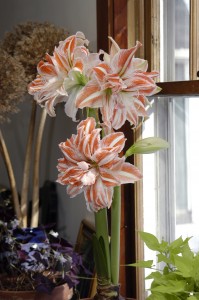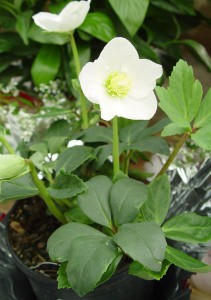5 Holiday Plants You Can Keep Going
December 16th, 2014
The Christmas tree is on its death bed the second it’s cut in the field.

Amaryllis is one holiday plant you can keep going for years. This one is a double one called ‘Dancing Queen’ from Colorblends.
(Credit: Colorblends Inc.)
Poinsettias are bred as throw-away plants.
But what about the other holiday plants that end up as home décor or gifts this time of year?
It’d be nice if they served a longer purpose beyond December.
A lot of them will with only limited gardener skill.
The trick is picking plants that are both interesting enough for holiday gifting and/or decorating and tough enough to survive the typical abuse of a dry-air, limited-light, living-room pot.
Have it both ways with these five holiday survivors:
* Amaryllis. Other than the poinsettia, this non-cold-hardy South American bulb is our second favorite holiday plant – available in garden centers and mass merchants everywhere.
Take the easy route by buying amaryllis that are already potted and about to flower, but it’s almost as easy to start those seemingly lifeless brown orbs from scratch.
Just set them with the very bottom of the bulb in a pot with drainage holes that’s filled with potting mix. Keep damp, and within days, green shoots will emerge. Within 4 to 6 weeks, you’ll get one or more clusters of showy, trumpet-shaped, tropical flowers.
Instead of tossing them after bloom, just cut off the flowering stalks. Keep the leafy growth near a sunny window, and treat it like a houseplant. Keep the soil damp (never soggy), and give the plant a monthly dose of liquid, balanced fertilizer.
Come mid to late May, move your amaryllis plant outside. Get it used to the outdoors gradually over a week or so, then either plant it in a sunny spot or grow it as an outdoor potted plant all summer.
In late September, cut off all foliage, dig the bulb, and store it inside – dry without soil. Temperatures around 50-55 are ideal, but I’ve just tossed amaryllis bulbs on a work bench in the garage and had them survive.
After letting the bulb “rest” dormant for 6 to 8 weeks, pot it up inside to start a new cycle.
* Christmas cactus. These are flowing, flowering plants – usually grown in hanging baskets – that look their best when bought new under ideal conditions in a greenhouse.
What fakes people out is Christmas cactus often gets rangy without pruning and also may not flower again if care is out of whack.
Watering is one issue. Although the name says “cactus,” this plant isn’t a desert species and isn’t fond of extended periods without water.
It’ll wilt soon after the top half of the soil goes dry. Keep your plant consistently damp but never soggy! Make sure the pot has holes in the bottom to let out excess water, and don’t overdo it with too much or too frequent watering.
After blooming, pinch back or snip off stems that are getting too long. These can be stuck in damp potting mix to root into new plants, if you want to give that a try.
Light is the key to good rebloom. If you grow your Christmas cactus as a year-round houseplant, keep it in a bright setting.
Better yet, move it outside in a shady or afternoon-shaded spot between late May and late September. In or out, fertilize it monthly with a balanced houseplant fertilizer.
What triggers a new round of flowering is either 12 hours of darkness a night (easy to pull off inside unless you’re storing the plant in a room that’s always lit) or temperatures in the 50-55 range.
Move your plant to a cool room that gets dark at night in late October to early November to time your rebloom for Christmas.
All of that may sound complicated. But take heart in knowing that some people do absolutely nothing to Christmas cactus (other than water it when it’s about to wilt) and have it bloom spectacularly year after year.
* Christmas rose. This relative newcomer to the December arsenal isn’t a rose at all but a perennial flower better known as a hellebore to avid gardeners or Helleborus niger to addicted gardeners.
Christmas rose is one of the earliest flowers to bloom, and in a greenhouse setting, it can be brought into full flower weeks before Christmas.
Unlike most other holiday plants, this one is cold-hardy enough to survive outside year after year in Harrisburg-area gardens.
If the ground isn’t frozen, you can actually plant Christmas rose outside in January. If everything’s snow-covered then, keep the plant in a cold garage until spring planting.
A shady to partly shady spot is ideal in a garden. So is good drainage (i.e. no wet clay).
Cut off leaves that brown over winter, but otherwise just stand back and watch it grow and flower like any other perennial.
In ensuing years, the usual outside bloom time is February or March.
Note: Hellebores are poisonous plants, so don’t let pets or infants nibble on them.
* Norfolk Island pine. This is the evergreen that’s not really an evergreen – at least not in our area.
Stores and garden centers often decorate these little potted soft-needled plants for the holidays so they can be used as living indoor Christmas trees. Or you can buy them bare and decorate them yourself.
In tropical climates, Norfolk Island pine grows into a big tree just like our firs and pines and spruce. However, it’s a species that doesn’t tolerate frost, so if you try to plant this one outside, it’ll be brown and dead by late next fall.
Norfolk Island pines do best as potted plants that are moved outside to a shady or semi-shaded patio in summer, then brought back inside for winter.
With a little fertilizer, re-potting and no over-watering, you might be able to keep this one going for a dozen or more years before it starts to get too big or gangly.
* Orchids. You probably think these are living on borrowed time in the hands of anyone other than a skilled horticulturist.
The truth is many orchids are easier to grow than their finicky reputations – especially the moth orchids that are most commonly sold.
For one thing, some orchid varieties are now mass-produced and are much cheaper than ever. Far more of them are ending up in homes, timed to bloom for December holidays.
Orchids also look elegant and seem posh, but most don’t require special babying to keep them alive. So you’ll come across as more green-thumbish than you really are by taking a crack at keeping these.
Try this. Start with a moth orchid potted in pine bark. These are less likely to root-rot in wetness – the leading killer of orchids.
Keep your orchid in a bright spot inside but out of direct afternoon sun.
Once a week, take the pot to the sink and run at least a gallon of room-temperature water through the pot and out the bottom. Then give it a half-strength dose of a liquid fertilizer formulated for orchids.
When all flowers finish on a stem, cut it back to its base. Repot the orchid into fresh bark in late spring – in a slightly bigger pot if necessary.
Come late May, move the potted plant outside and grow it there in a shady or afternoon-shaded spot all summer. Wet it once or twice a week and fertilize it every 2 to 4 weeks until bringing it back inside by the end of September.
The shortening daylight and cooler nights are what will soon trigger a new round of flowering.
By the way, those blue orchids you’re seeing lately really aren’t blue. They’re white ones dyed blue.
So if you get your plant to flower again next fall and winter, expect the flowers to be white.
But then you can claim you have the botanic magic to make flowers change color.









